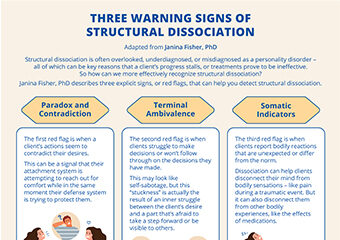Like many of the emerging defense responses to trauma, the collapse/submit response can be difficult to recognize. So to give you a clearer idea of what this trauma response can look like, we created this free infographic that highlights four key ways it might present in a client. To put this infographic together, we gathered […]
Is Your Patient “Feeling” Unworthy? What May Be the Underlying Cause, with Janina Fisher, PhD
Trauma can leave a patient with a deep sense of unworthiness. On top of that, your client might even blame themselves for feeling this way. But as we know, there’s always a purpose behind a patient’s response to trauma. And sometimes, the challenge is getting your patient to see the wisdom behind their response – […]
[Infographic] – Three Warning Signs of Structural Dissociation
Working with structural dissociation can be critical in the treatment of severe or prolonged trauma . . . . . . but it’s often difficult to detect. According to Janina Fisher, PhD, structural dissociation is commonly underdiagnosed, or it’s misdiagnosed as a personality disorder. And when left undetected, it could lead to ineffective treatments that […]
A Three-Step Approach to Treating Trauma-Related Dissociation, with Thema Bryant, PhD
Dissociation can be tricky to spot. On top of that, it can look awfully similar to freeze or shutdown. And to complicate things further, a patient might dissociate when they’re in either one of those trauma responses. But being able to detect when a client is dissociating is critical for providing effective treatment. So in […]
What’s Happening in the Nervous System of Patients Who “Please and Appease” (or Fawn) in Response to Trauma? With Stephen Porges, PhD
You’ve probably heard of fight, flight, and even the freeze response to trauma. But there are some newer defense responses – ones that experts have only recently begun to name and understand – that are critical to our clinical work. One of those defense responses is “please and appease.” You may have also heard expert […]




